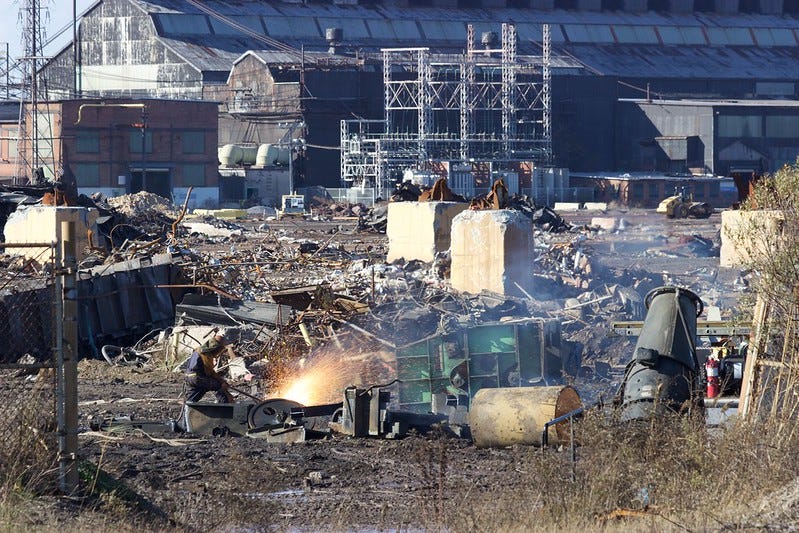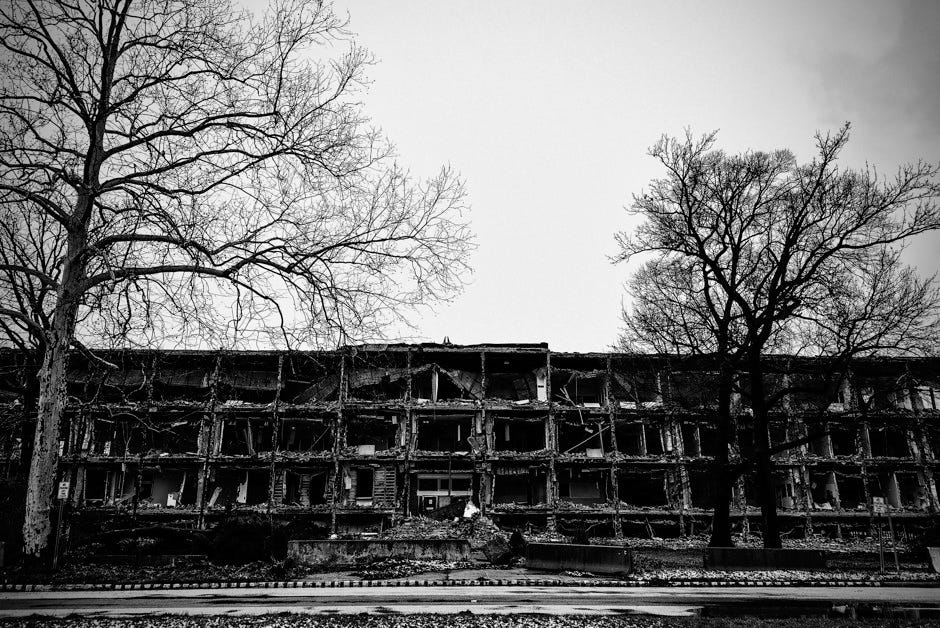The Death of The Bethlehem Mill
A look at a 20th century industrial marvel through the lens of capitalism and sustainability
“Sorry, the facility manager’s plant car blew out an axle. He’ll be here a few minutes late.”
Those were the first words spoken to me upon my initial visit to Sparrow’s Point, Maryland, about a decade ago.
“What’s a ‘plant car?’” I inquired.
Had I paid closer attention, the shiny recent model rental car I drove into the facility where I’d be doing remediation consulting for the next week stuck out like a sore thumb in the dusty parking lot. It was a graveyard of cheap twenty-year-old sedans. Rusty Honda Civics, Geo Metros, and Mazda 323s. Not a pickup in sight, save for the white company-owned trucks adorned with a logo and orange stripes.
A plant car, as it turns out, is a beater that workers kept at the Port of Sparrows Point entry gate 3 miles away. These guys had figured out years ago that the toxic slurry of heavy metals and acids embedded in every square inch of ground in the port complex played absolute hell on their personal vehicles. It was better to sacrifice a $500 car, the absolute cheapest, high-mile garbage they could find on craigslist than ruin their own personal cars they used to take their kids to school or grab groceries on the weekends.
Sparrow’s Point is one of the most fascinating industrial sites I’ve visited in my career. As a huge fan of industrial tourism, I love seeing it all: modern factories churning out goods, terminals moving millions of tons of bulk coal, or chemical plants with a smattering of new and ancient equipment and a rat’s nest of pipes turning simple hydrocarbons into complex paints, coatings and adjuncts.
Scrapping operations spent decades clearing this stuff out. Before the sun rose in the morning, you could see in the distance flashes of the green-blue flame of cutting torches breaking down the garbage and scrap.

Sparrow’s Point was but a shell of its former self by 2014. There were a few small bulk and liquid terminals, a handful of dry dock operations, and some asphalt plants. The last holdouts. The majority of the 3000-acre industrial site was a graveyard. A smattering of hollowed-out buildings remained, but most of the land mass was just debris. Mountains of old, rusted steel beams and 100-year-old barrels. Asbestos-containing sidings and insulation. Long dead machines of industry.
But it wasn’t always that way.
Sparrow’s Point peaked just after World War II. But at its height, the Maryland Steel Mill was one of the largest in the world. The industrial complex also housed a shipbuilding yard, originally constructed in 1891 by the Maryland Steel Company. The Shipyard and the Mill were accompanied by coal and slag processing and storage facilities. A vertically integrated industrial mega-hub on the mouth of the Patapsco River as it feeds into the greater Chesapeake Bay.

If you visited any site on the industrial complex in 2013 still staffed by United Steel Worker union members, part of your site safety orientation involved a quick 15-minute lesson about the history of the complex. I’m still beating myself up that I didn’t keep a souvenir copy of the union history flyer they handed out, but much of that history is thankfully maintained in University and Self-published websites.
The Maryland Steel Shipyard, at the peak of WWII, was cranking out an entire Liberty Class ship every single week. As part of a larger effort, the USA produced over 2,700 of these mid-sized ships in 18 shipyards from 1941 to 1945. The versatility and speed of the vessels played an essential role in the US Navy dominating the oceans on both the Pacific and Atlantic fronts. The Liberty program was undoubtedly one of the greatest feats in modern industrial production history.
Like any well-entrenched union, the USW Local 9477 was, and is, as much a part of the community as any church or town square. Nearly every USW employee you talked to was a second, third, or fourth-generation union guy. Benny, the retired steelworker, who volunteered his time giving history lessons, told me that his father died during the Liberty ship push. Fell from a height of over 50 feet to his death while welding. To Benny, his father was no less a war hero than a soldier who was killed at Iwo Jima or storming the beach at Normandy. I’m inclined to agree.
Following the war, the Steel Company was flush with cash. In 1947, the facility installed a new blast furnace and a 68-inch hot strip mill. The strip mill, at the time the biggest and most modern in the world, would produce sheet steel continuously until the facility’s closure in 2012.
The following 60 years of economic development globally would not be so kind to the facility. Shipmaking and Steelmaking are somewhat counter-cyclical; when steel margins are high, leading ship orders drop off precipitously, for example. Vertical integration provided some buffer but never enough profit in the good times to please investors.
The Maryland Steel facility was eventually acquired by Bethlehem Steel in 1961 after years of losses. BethShip (Bethlehem’s shipbuilding subsidiary) took control of the shipyard, which continued to produce vessels, although at smaller and smaller volumes, until 1990.
The global industrial rise of South American and Asian durable goods manufacturing also weighed heavily. The Sparrows Point site was an ideal location to launch and build ships from, but the transportation of raw material to the site would continue to be a burden, with poor rail access and a long distance to coal and iron mining in particular hurting. The 1970s, an era of inflation, political turmoil, and sluggish growth would wipe out huge swaths of the American Industrial base.
The Sparrow’s Point complex stayed afloat. In 1977, Bethlehem installed a new blast furnace, the massive “L” unit, a modern coal-fired behemoth that was intended to make the plant competitive on a unit efficiency basis.
This Furnace couldn’t have been installed at a worse time. The unit was one of the earliest to be subject to the costly, industry-specific requirements under the Clean Air Act Amendments of 1977 for “New and Reconstructed” sources of air emissions. Adding insult to injury, the early 1980s saw the rise of the large-scale Electric Arc Furnace (EAF). Where a blast furnace, such as Sparrow Point’s “L,” uses the heat of combustion to melt slag and scrap into its molten form, EAFs use a massive electrical arc to instantly turn metal into a liquid. EAF wasn’t exactly a new process, having been used since the early 1900s for smaller alloy batches. But as a replacement in large scale smelting, the EAF was a game changer.
The US Government coordinated the gutting of labor protections throughout the 1980s, along with a new age of corporate financing, helping to spur some additional industrial growth in the US. Sparrow’s Point would limp on, however. Some 7,000 employees still worked at the site in the late 1980s, down 60% from the heyday a few decades earlier. The Signing of The North America Free Trade Agreement (NAFTA) in 1989 and its subsequent effectiveness in 1994 would be the death warrant for Sparrow’s Point.
In a way, it’s pretty amazing that steel kept coming out of this facility until 2012. Rolling shutdowns and furloughs would be a characteristic of the years to come following NAFTA. The site was dying, albeit slowly. Bethlehem Steel declared bankruptcy in 2001, and the Sparrow’s Point operation would be traded around by Private Equity Firms for the next decade. Each ownership transfer came with layoffs and cost-cutting. The tendrils of capitalism stripped every monetizable asset they could, year by year.
Assets and plants were decommissioned nearly every year following the finalization of the Bethlehem Bankruptcy in 2003. Like a slow-moving domino display, towering buildings of industry that once hummed with life and activity, were shuttered and then demolished and toppled over.

In December 1978, just after the commissioning of the big L furnace, workers welded a massive star, adorned it with lights, and perched it at the top of the towering structure. The “Bethlehem Star” would be lit up every year at Christmas time and was an iconic, shining, whimsical beacon among the gritty industrial backdrop. In December of 2012, the star was lit for the last time, shortly after the facility produced its last steel rebar

The decay of Sparrow’s Point and the surrounding neighborhoods had been a long time coming. No union jobs meant higher unemployment, crumbling housing, and a rapidly contracting tax base to pay for utilities and schools. The piles of debris that littered Sparrow’s Point were mirrored in the surrounding community itself.
Want more content like this? Click the button below 👇
It was abundantly clear from the offset that the former industrial park was a bit of a mess. “A Mess” is an understatement, of course. The land was (and remains) a Superfund site. The Superfund program is part of the 1980 Comprehensive Environmental Response, Compensation, and Liability Act (CERCLA) law that outlines cleanup requirements for sites that had suffered severe environmental degradation via the spillage of pollution.
The liability for cleanup in CERCLA and the Resource Conservation and Recovery Act (RCRA, 1976) is supposed to be a cradle-to-grave mechanism, whereby operators who drop hazardous material on the ground, as well as generators who make waste that’s shipped offsite, must pay for all of the costs, with the taxpayer picking up the slack when the costs cannot be covered even in liquidation or bankruptcy.
By the time RCRA and CERCLA were promulgated, the Sparrow’s Point site had nearly a century of radioactive fly ash, spent oil, heavy metals, and other toxic compounds like vanadium pentoxide layered with silt and dirt in first several feet below ground. A decade after the last steel plate left the Bethelham mill, and it’s still very much a work in progress.
Industry scorched the earth, and it’s a real shame; the low-lying tidal marsh once had extremely fertile soil and was settled by homesteading farmers in the 1600s. In the centuries prior, Native American tribes lived off the land with access to salt and fresh water, and ample habitats for hunting. The unique geography of the land made the climate on the land mass made it slightly milder, protected from huge blizzard events by the ocean and from strong Atlantic storms by the Iconic Eastern Penninsula of Maryland.
The site would’ve, perhaps, been perfect for a mixed residential and commercial township. Some people wanted a wildlife preserve to be grown from the ashes. But the cleanup costs to get the site to a level that allowed the land to be used for living simply were too expensive. The Private Equity firms who carved up assets and squeezed every cent out before closing shop left the only thing with remaining economic value: land.
And so the once formidable industrial hub is now slotted one ring below on the real estate hierarchy. It’s going to be distribution centers. Amazon, Walmart, Home Depot. You can pour a 12-inch slab on top of a brownfield and build disposable warehouses to store disposable goods to feed our disposable lifestyle.
I was still Facebook friends with one of the Union guys who worked in Sparrows Point. I reached out to him last year. He’d retired in 2015; the pension retirement wasn’t as good as it should’ve been, but he’d be fine. His son, the fourth generation of USW stock, was working at a distribution warehouse in Sparrow’s Point, making a lower hourly wage than his father had 30 years earlier.
I don’t really have a huge point to make with this post, but I do find the metaphor of “the hoarder” instructive. If you’ve ever seen the show Hoarders, you’ve see the worst of people who struggle with mental illness as they fill their homes up with garbage, animals, knick-knacks, and other stuff they’re unable to part with. Some hoarders don’t even particularly use more stuff than an average US household. The stuff just lives with them, more of it with each passing year. At the end of every Hoarders episode, the years of trash and rot are cleaned out in one fell swoop. But it’s different than if the excesses had been dealt with daily or weekly. The weight of all the waste takes a toll on the house from foundation up. Not only physically, but also… spiritually?
That’s kind of how I think about the field of ESG or Corporate Stewardship. Sure, lots of it is fluff. But a century of proper waste management, manifesting, and maintenance at an industrial supersite isn’t that expensive on an annualized basis. It isn’t free, certainly. But those impacts, those of waste and disrepair and careless disregard add up. The negative impacts compound like a bad investment. Regulations have succeeded in many ways to force the issue, but I think it goes beyond that. If I’m a shareholder in, say, a chemical company and I believe that Capitalism is imperfect but still capable of making the world better than any other system, do I care about the fraction of a percent hit to net margins or a slightly lower dividend yield, if it means the company does a better job of stewardship than the companies that came before it? I’d like to think the answer is yes. It’s a lot better than what we’ve done up to this point.
Works Cited:
The Star of Bethlehem Lights up Steel Mill One Final Time (Baltimore Sun, 2012)
Back Story: Chronicling the history of The Sparrows Point Mill (Baltimore Sun)
Views of Sparrows Point: Early 20th Century (Baltimore Museum of Industry)
Sparrows Point Shipyard: 100 years of shipbuilding Baltimore Museum of Industry)
Six reasons why the Sparrows Point steel mill collapsed (Baltimore Brew)
Interviews Conducted by Myself







Is there any industry in the US which has prospered and continued a generation after the unionization of the workforce? UPS was an exception to the "unions destroy" rule. But look at how the Amazon delivery system has replaced UPS. Tesla is showing that the giga factory approach of centralizing production within a single facility is the key to producing great products at low cost. But you have to keep the union out. Otherwise, the massive investment by ownership is held hostage by unions that have the legal authority to shut down the operation of the plant.